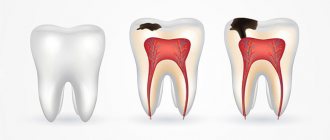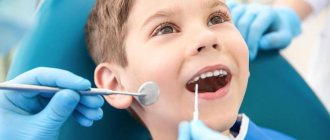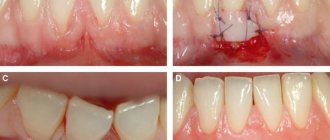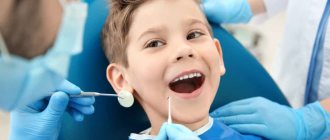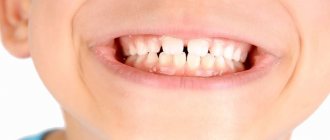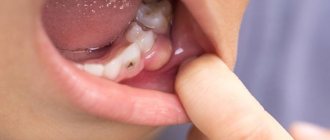Caries can affect children's teeth even at the eruption stage. By the age of 7 years, it is diagnosed in 80% of young patients. But most parents do not focus on this problem. Meanwhile, it is necessary to treat not only permanent teeth, but also milk teeth, since they are also susceptible to pulpitis and can cause purulent infection and other complications. To treat caries in children today, it is not necessary to drill teeth. Modern dentistry has minimally invasive techniques - silvering, fluoridation, infiltration.
Causes of caries of temporary teeth
Factors influencing the formation of caries on primary teeth can be divided into local and general
- Local factors:
- Pathogenic microflora in the oral cavity. This is the most common cause of caries in children. A change in one's own microflora can occur due to the ingress of foreign microflora. For example, a pathogenic environment can be transmitted to a child from parents or those who care for him. Therefore, it is important that parents' oral cavity is healthy.
- Poor hygiene. If the baby does not have oral hygiene, then bacteria accumulate on the teeth, which negatively affects tooth enamel and provokes the development of caries.
- Enamel hypoplasia. This pathology occurs even before the eruption of the first teeth directly in their rudiments. The cause of hypoplasia is a violation of metabolic processes, as well as protein and mineral metabolism in the body of a child or even a fetus. The defect provokes the development of caries, as tooth enamel loses its protective properties.
- Nutritional features. Diet greatly affects the condition of teeth. Foods containing large amounts of sugar (for example, baby juices and cereals) can trigger caries. If a child wakes up at night to eat, then the teeth are also subject to destruction, since food particles remain on them, which rot during sleep. At night, the production of saliva is reduced, which washes the oral cavity and provides protection to the teeth and mucous membranes.
- General factors:
- Weakened immunity. Children with weak immunity often suffer from viral and infectious diseases. During these periods, the composition of saliva changes: the level of protective substances in it decreases, which prevent the growth of bacteria. Therefore, children with weak immunity develop caries more often.
- Deficiency of vitamins and microelements. Typically, a deficiency state occurs due to improper and unbalanced nutrition, when the body does not receive enough nutrients. Because of this, saliva and, accordingly, tooth enamel have a low level of mineralization. The quality of complementary foods directly affects the condition of teeth. These should be not only sweet purees containing sugar, but also cottage cheese, vegetable purees and other foods containing vitamins and microelements.
- Chronic diseases. The presence of chronic diseases negatively affects not only the entire body, but also the condition of the teeth. These diseases include: frequent colds
- rickets
- dyspepsia (indigestion)
- exudative diathesis
- gastroenterocolitis
- dysfunction of the endocrine glands
- Iron-deficiency anemia
- measles, scarlet fever
- diphtheria
- dysentery
- pneumonia
- whooping cough, etc.
All these diseases affect the composition of saliva and make it pathogenic.
- The course of the mother's pregnancy. The rudiments of baby teeth are formed during the formation of the fetus in the womb. Therefore, it is important that the mother is healthy. One of the factors that negatively affects the development of a child’s teeth is toxicosis. According to statistics, mothers who have had late toxicosis are more likely to give birth to children who experience caries of primary teeth between the ages of 1 and 3 years.
- Mother's illnesses during pregnancy. Diseases such as rheumatism, heart defects, hypertension, arterial hypotension, endocrine diseases, diseases of the gastrointestinal tract, kidneys, blood, etc. negatively affect not only the formation of teeth, but also all other tissues of the unborn baby’s body.
- Bad habits of the mother during pregnancy. Alcoholic drinks, medications, tobacco smoke: all this affects the child. In the fetus, the rudiments of temporary and permanent teeth are affected, anomalies of the hard tissues of dental units are formed, and the mineralization of enamel is disrupted. All these disorders cause low resistance of teeth to caries.
Causes of the disease
In some cases, early carious lesions of primary teeth are caused by damage to the tooth germs during the period of intrauterine development (in the third trimester of pregnancy).
Factors that can provoke the occurrence of violations of this kind are:
- illnesses suffered by a pregnant woman;
- refusal to lead a healthy and active lifestyle during pregnancy;
- prescribing certain groups of medications to the expectant mother.
The most common causes of caries development after teething are:
- irresponsible attitude towards compliance with hygiene requirements;
- prescribing medications to the child that have a negative effect on the condition of the enamel layer;
- deficiency of calcium and fluoride in the baby’s food;
- abuse of sweets and other bad eating habits.
Symptoms of caries in primary teeth
In children, caries is located mainly in the cervical region on the upper front teeth and in the grooves of the first and second molars. The infection quickly turns from a small spot into a large spot that covers the entire tooth. In an advanced state, the disease leads to the tooth simply breaking off.
In the early stages of caries, the disease is not accompanied by any symptoms. Sometimes children may complain of short-term pain and discomfort when eating sweet and sour foods, which quickly passes.
When the infection spreads to the contact surfaces, the teeth may feel like they are bursting, as if pieces of food are stuck between them. In addition, the gums become inflamed and bleed.
Deep carious lesions cause damage to the integrity of not only the enamel, but also the dentin of the teeth. The higher the activity of the infectious process, the greater the damage to dentin tissue.
Caries may be limited to the front surface of the teeth, or may be localized on contact surfaces. In the latter case, the disease causes the tooth crown to break off. In this case, pulpitis often occurs - inflammation of the nerve bundle inside the tooth. These pathologies are accompanied by severe pain.
What is pulpitis?
Pulpitis is a process of inflammation in the tissues inside the tooth, where the nerves and blood vessels are located. In children, this process is recorded much more often than in adults. This is especially true for temporary teeth.
The baby teeth
themselves are smaller in size, so both the dentin layer and the enamel layer are thinner, through which infection penetrates more easily.
The body's defenses in childhood are not yet fully developed and weakly fight infection. As a result, the rapid development of caries and pulpitis.
Treatment methods for caries of temporary teeth
There are 2 groups of methods for treating caries of primary teeth:
- Non-invasive – techniques that do not involve surgical intervention. They are used in the initial stages of diseases with superficial caries. These include:
- Remineralization of teeth. The procedure is aimed at restoring the mineral composition of the hard tissues of the tooth and is carried out using preparations containing calcium and fluoride. Remineralization can be performed both in the clinic and at home.
- Deep fluoridation. It involves treating teeth with a special agent that provokes the formation of highly dispersed calcium fluoride. The latter, in turn, is a conductor of minerals that fill voids in tooth enamel, strengthening it. At home, it is possible to use calcium-containing gels, for example, Tooth Mousse, ROCS medical minerals, etc.
- Impregnation method (silvering) – filling of root canals. An alcohol solution of silver nitrate is used for the procedure. This product promotes the formation of albuminates, which form a protective film on the surface of enamel or dentin. The disadvantage of silver plating is that it temporarily turns the tooth black.
- Invasive – surgical methods used in the treatment of medium and deep caries.
- Infiltration of enamel with “Icon” material. This is a modern microinvasive technique for caries treatment. The main goal of the procedure is to restore the hard tissues of the tooth by filling voids in the enamel that can allow acids and minerals to pass through. The active ingredient is a 15% solution of hydrochloric acid. After it, the teeth are treated with synthetic resins, which penetrate into the cavities in which there was caries and fill them.
- Preparation of caries. This procedure involves mechanical removal of caries from the surface of the teeth using a drill. If the carious lesions are small, then you can get by with a hand tool - an excavator. If you need to treat a large number of teeth, it is better to do it under general anesthesia or sedation.
After removing the caries, the doctor performs a filling using the following materials:
- composite fillings;
- glass ionomer cements;
- compomers.
Primary teeth are usually filled with glass ionomer cements due to their good adhesive and anti-carious properties.
If most of the coronal part of the tooth is destroyed, then the unit is restored using a crown. The denture protects the tooth from plaque and bacteria, as well as the effects of other external factors (hot and cold food).
How is chronic periodontitis treated?
Treatment of periodontitis is long and complex and does not always result in a cure. In temporary teeth, most often the tooth affected by periodontitis has to be removed.
Treatment of this disease in permanent teeth consists of eliminating the pathological process. With subsequent sanitation of the inflammatory focus and filling of the destroyed canal. Lack of treatment leads to damage to the root and cortical area. With treatment performed by a specialist and the use of high-quality materials, the symptoms, as well as the disease itself, in the affected area can be eliminated for a long time.
Prevention of caries in baby teeth
When diagnosing caries of primary teeth at an early stage, the prognosis for treatment of the disease is favorable. If the disease was discovered when it was in an advanced form, then premature tooth loss or death of the molar tooth germ may occur. In any case, it is necessary to carry out treatment and follow-up monitoring. Preventive examinations by a specialist should be carried out once every 2-3 months.
For timely prevention of caries of primary teeth, it is necessary to eliminate risk factors for the development of the disease and control:
- Mother's health during pregnancy.
- The course of labor.
- The condition of the child after birth.
- Character and mode of feeding.
- Taking medications in a child.
To maintain the health of your child’s teeth, you must follow the following recommendations:
- Carry out the first examination by a pediatrician within a month after the birth of the child. A specialist will be able to assess risk factors for the development of pathologies in the body, including in the oral cavity. If any are identified, the doctor will give advice on preventing the development of dental diseases.
- When a child’s first teeth erupt, their hygiene should be carried out using special napkins or fabric rags soaked in boiled water. You can also use rubber finger brushes with polymer bristles.
- It is necessary to select toothpastes that are appropriate for the child’s age. They will not harm the body if swallowed and do not contain dyes or harmful chemicals.
- If your child has eaten sweets, you need to brush or wipe his teeth. Leftover sweet foods should not remain in the mouth for long, as refined carbohydrates have a negative effect on them, causing tooth decay.
- It is recommended to periodically treat baby teeth with gels containing calcium.
- On chewing teeth, you can close fissures (natural depressions on the surface of the enamel). This is an easy and painless procedure performed using dental sealants.
As you know, the best treatment is prevention. Therefore, it is important to visit pediatric dentists promptly and regularly. One of the best dental clinics in St. Petersburg is “World of Dentistry”. Experienced specialists work here who know how to find an approach to small patients and provide high-quality treatment in an atmosphere of absolute comfort.
Is it possible to completely prevent the development of caries in childhood?
Perhaps, if parents conscientiously follow all the doctor’s recommendations regarding nutrition and the prevention of carious lesions, they systematically come for preventive examinations, which are prescribed by the attending physician.
It is necessary to take care of baby teeth and carry out treatment in a timely manner. You need to take care of your child’s teeth from the appearance of the first tooth. Parents should approach oral care responsibly, teaching their child to take care of hygiene. It is not difficult to interest a child now - parents will be helped by unusually designed toothbrushes, pleasant-tasting toothpastes, and, if desired, even such a routine activity as brushing teeth can be turned into an interesting game.
Pediatric dentistry will help you - during your appointment at our clinic, hygiene lessons are held - specialists tell and show how to properly brush your teeth. Let your children be healthy, happy and smiling!

